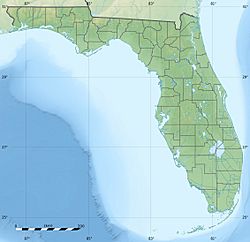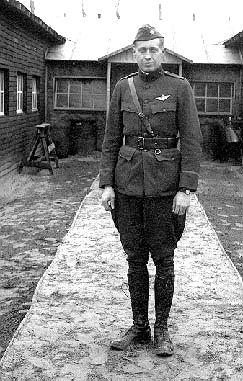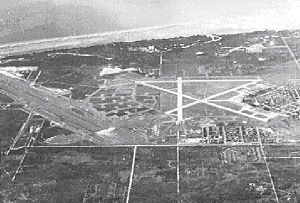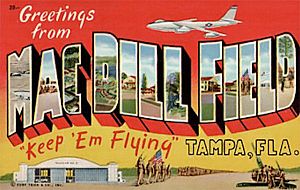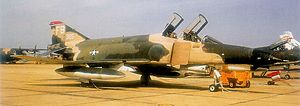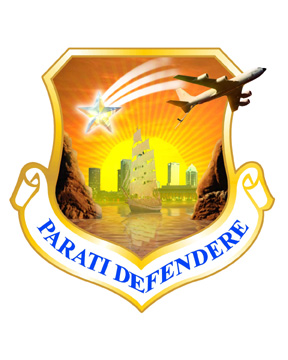MacDill Air Force Base facts for kids
Quick facts for kids MacDill Air Force Base |
|||||||
|---|---|---|---|---|---|---|---|
| Near Tampa, Florida in the United States | |||||||

The main gate at MacDill AFB, with a KC-135R Stratotanker overhead.
|
|||||||
 |
|||||||
| Coordinates | 27°50′58″N 082°31′16″W / 27.84944°N 82.52111°W | ||||||
| Type | US Air Force Base | ||||||
| Site information | |||||||
| Owner | Department of Defense | ||||||
| Operator | US Air Force | ||||||
| Controlled by | Air Mobility Command (AMC) | ||||||
| Condition | Operational | ||||||
| Site history | |||||||
| Built | 1939 (as Southeast Air Base, Tampa) | ||||||
| In use | 1939–present | ||||||
| Garrison information | |||||||
| Current commander |
|
||||||
| Garrison |
|
||||||
| Airfield information | |||||||
| Identifiers | IATA: MCF, ICAO: KMCF, FAA LID: MCF, WMO: 747880 | ||||||
| Elevation | 4.2 metres (14 ft) AMSL | ||||||
|
|||||||
MacDill Air Force Base (often called MacDill AFB) is an important United States Air Force base. It is located about 4 miles (6.4 km) south of downtown Tampa, Florida.
The main unit at MacDill AFB is the 6th Air Refueling Wing (6 ARW). This group is part of the Air Mobility Command. The 6 ARW is in charge of running the base. It also performs important missions like refueling aircraft in the air.
MacDill Air Force Base was built just before World War II. It started as MacDill Field for the U.S. Army Air Corps. After the U.S. Air Force became its own military branch in 1947, it was renamed MacDill Air Force Base. Over the years, the base has been home to many different types of aircraft. These include B-47 Stratojet bombers and F-4 Phantom II and F-16 Fighting Falcon fighter jets. Since 1996, it has been an Air Mobility Command base. Its main job is air refueling.
MacDill AFB is also home to the main offices for two major U.S. military commands. These are United States Central Command (USCENTCOM) and United States Special Operations Command (USSOCOM). These commands are very important for planning and leading military operations around the world.
Contents
History of MacDill Air Force Base
MacDill Air Force Base started in 1939 as Southeast Air Base, Tampa. It was named after Colonel Leslie MacDill. He was a pilot in World War I. Sadly, Colonel MacDill died in a plane crash in 1938.
The base officially opened on April 16, 1941. It was renamed MacDill Field on December 1, 1939.
Early Missions and World War II
When World War II began in Europe, the U.S. worried about German submarines. These submarines could attack American ships in the Gulf of Mexico. MacDill Field's first job was to defend the Gulf.
Flying started at MacDill in February 1941. Pilots flew patrols to look for submarines. They used planes like the Boeing B-17 Flying Fortress. The base also helped send combat planes to the Philippines.
During World War II, MacDill Field became a major training center. It trained crews for bomber planes. Many pilots learned to fly the B-26 Marauder here. This plane was tricky to fly at first. But later versions became very successful.
The base also trained crews for the Boeing B-17 Flying Fortress. These crews went on to fight in Europe. Thousands of troops were stationed at MacDill during the war. The base provided entertainment like concerts and movies.
MacDill also held German prisoners of war (POWs) in 1944 and 1945. Later in the war, it trained crews for the Boeing B-29 Superfortress. This was a very large bomber. After the war ended in 1945, MacDill helped process soldiers returning home.
The Cold War Era
After World War II, MacDill became part of the Strategic Air Command (SAC). This command was in charge of nuclear bombers. In 1946, the 307th Bombardment Group was based here. They flew B-29 Superfortress planes.
In 1950, the 307th Bomb Group deployed to Okinawa. They flew combat missions during the Korean War. They attacked enemy forces in Korea.
In 1950, the 306th Bombardment Wing arrived. It was the first SAC unit to use the new B-47 Stratojet jet bomber. The 306th helped develop new ways to use these jets. They even deployed B-47s to England for training.
MacDill AFB was also used for filming parts of the movie Strategic Air Command in 1954–55. This movie starred James Stewart.
Changes and New Missions
In the early 1960s, MacDill AFB changed from a bomber base to a fighter jet base. It was transferred to the Tactical Air Command (TAC). This happened after the Cuban Missile Crisis in 1962. The base's location was very important during this time.
Fighter Jet Era
The 12th Tactical Fighter Wing and 15th Tactical Fighter Wing were based at MacDill. They flew F-84 Thunderjets and later the McDonnell Douglas F-4 Phantom II. These wings trained fighter pilots. Many pilots trained here before going to fight in the Vietnam War.
During the Cuban Missile Crisis, many fighter jets were sent to MacDill. They were ready for possible airstrikes on Cuba. But the crisis was solved peacefully.
Later, the 1st Tactical Fighter Wing and then the 56th Tactical Fighter Wing were stationed at MacDill. They continued training F-4 pilots. In the 1980s, the base received the new F-16 Fighting Falcon jets. The 56th Wing became the 56th Tactical Training Wing.
MacDill AFB also hosted the Super Bowl XVIII and Super Bowl XXV flyovers. F-16 jets from the base flew over the stadium.
After the Cold War
In the early 1990s, the military planned to close MacDill AFB. This was because of the end of the Cold War. Also, there was a lot of civilian air traffic nearby. But local leaders fought to keep the base open.
New Role as an Air Mobility Base
In 1993, the closure order was canceled. The National Oceanic and Atmospheric Administration (NOAA) moved its aircraft operations to MacDill. This showed the base's runways were still useful.
In 1996, MacDill became an Air Mobility Command base. The 6th Air Refueling Wing (6 ARW) moved here. They brought KC-135 Stratotanker aircraft. These planes refuel other aircraft in the air. This is a very important mission.
In 2008, the 927th Air Refueling Wing joined MacDill. This is a Reserve unit. They also fly KC-135R aircraft. They work together with the 6 ARW.
In 2017, NOAA moved its aircraft operations to another airport. This was to make room for more KC-135R aircraft at MacDill. The base plans to add more KC-135R planes in the future. It will also get new Boeing KC-46 Pegasus refueling aircraft.
What MacDill Air Force Base Does Today
MacDill Air Force Base is a very busy place. About 15,000 people work there. Many military families live on base. The base helps the local economy in Tampa. The city of Tampa is very supportive of the military community.
The base has many facilities for military members and their families. These include lodging, a grocery store (commissary), a department store (base exchange), and recreation areas. There is a swimming pool, a movie theater, and a golf course.
The 6th Air Refueling Wing
The 6th Air Refueling Wing (6 ARW) is the main unit at MacDill. It has about 3,000 people. Its main job is to refuel aircraft in the air. This allows other planes to fly longer missions. The 6 ARW has several squadrons:
- The 91st Air Refueling Squadron and 50th Air Refueling Squadron fly the Boeing KC-135 Stratotanker. They refuel aircraft all over the world.
- The 6th Operations Support Squadron manages the airfield. They handle air traffic control and weather services.
- The 6th Maintenance Group keeps the aircraft in good working order.
- The 6th Medical Group provides healthcare for base personnel.
- The 6th Mission Support Group handles many services. These include communications, civil engineering, and security.
The 927th Air Refueling Wing
The 927th Air Refueling Wing (927 ARW) is a Reserve unit. It works closely with the 6th Air Refueling Wing. They share the same KC-135R aircraft. This means both active duty and Reserve pilots fly the same planes. The 927 ARW has about 1,000 personnel. They are part-time or full-time Reservists.
The 927 ARW includes the 63d Air Refueling Squadron. This squadron also flies the KC-135R Stratotanker.
Other Important Units at MacDill
MacDill has many other important units. These are called "mission partners." Some of them include:
- United States Central Command (USCENTCOM): This command directs U.S. military operations in the Middle East and Central Asia.
- United States Special Operations Command (USSOCOM): This command oversees special operations forces.
- United States Marine Forces Central Command (MARCENT): This is the Marine Corps part of USCENTCOM.
- Special Operations Command Central (SOCCENT): This is the special operations part of USCENTCOM.
- Navy Operational Support Center Tampa: This unit supports Navy Reserve personnel.
- Joint Communications Support Element (JCSE): This group provides communication support for military operations.
- 598th Range Squadron: This unit manages the nearby Avon Park Air Force Range. This range is used for military training.
- Joint Special Operations University (JSOU): This university provides education for special operations forces.
- Joint Forces Staff College Satellite Campus: This college trains military leaders.
Airshows at MacDill
MacDill AFB often hosts an air show called "AirFest." Thousands of people come to watch amazing aircraft displays. The show was canceled a few times due to security concerns or budget issues. But it is now held every two years. AirFest 2016 was the first time the show was broadcast live online. It featured the famous United States Air Force Thunderbirds flying team.
Images for kids


